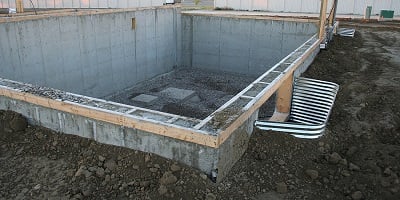We have all heard about the importance of building strong foundations. From education to relationships to buildings, it is common knowledge that a solid foundation is the first step to success. Although the word “foundation” has made its way into daily speech, perhaps nowhere is it more important than in construction. Let’s review how to properly anchor your foundation, so your building is properly supported and insulated from ground water.
Importance of a Foundation
Most people know that a foundation supports the building which sits on top of it. Fewer people realize that a foundation also acts as a dam, keeping groundwater out of the lowest levels of the property, which can lead to mold growth and, worse, undermine the integrity of the structure.
There are a variety of options for foundation construction—choosing the “correct” one is a matter of determining what best suits your project. A few variables include:
- The stability of the terrain you are building on.
- The horizontal forces the final structure will face, such as wind and rain.
- The vertical forces that will act on your structure, such as gravity and the building load.
Determining what kind of foundation is best suited for your construction project should be one of the first steps you take in planning your project. Ultimately, the type of foundation required for your structure will depend on the size of the structure, and what it will be used for. Once the plans for your structure are completed and the foundation is poured, it will be time to anchor your building to the foundation.
Anchoring Your Foundation
The strength of a metal structure is only as solid as the concrete foundation beneath it. Anchor rods, or anchor bolts, are steel rods that are set into concrete with the purpose of connecting the steel structure to the foundation. Anchor bolts are typically installed when a foundation is being laid; however, depending on the job, they may also be installed after the concrete is set. Ultimately, the type of anchor bolt used to adhere the steel structure to the foundation will be determined by the specifications of the building, the forces that will act on the building, such as high wind or rain, and the building codes of your state and municipality.
Wedge anchors consist of two parts—a straight pin with a bolt at the top. They are normally installed after the concrete foundation has been poured and sets. To adhere steel to concrete, these wedge bolts are placed into holds drilled into concrete. Once in place, a wedge anchor is designed to expand, thus providing a tight hold that relies on the friction of the surrounding concrete to remain in place.
Bent bolts are another option that can be used to adhere a steel frame to a concrete structure. Bent bolts have an ‘L’ shaped bend at the top and are placed when the concrete foundation is being poured, which makes them highly resistant to upheaval—perfect for large, heavy structures.
Fasteners for Every Job
ET&F® Fastening Systems is the world’s leading supplier of pneumatic fastening systems for concrete and construction. For more than 30 years, ET&F® (A member of the BECK Group) has pioneered the manufacturing and distribution of specialty tools for hardened steel pin fasteners for the construction industry. The ET&F® steel fastening solutions include a wide variety of tools as well as their high carbon, heat treated steel pins that are made with a ballistic point for penetration into the hardest substrates making for a more efficient and safe working environment. Click below to learn more about efficiency in steel construction.
.svg.png)


